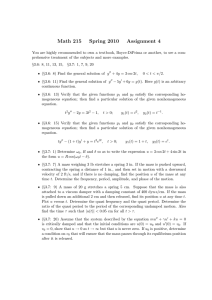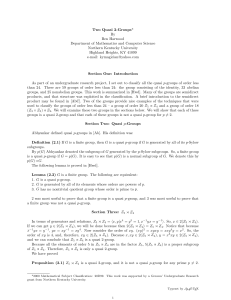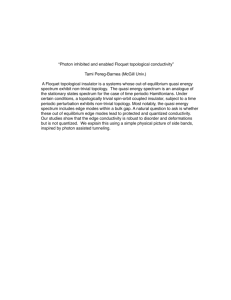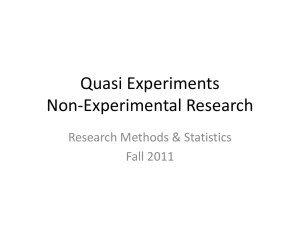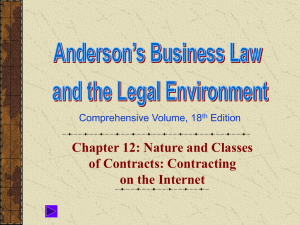p By Ben Harwood Department of Mathematics and Computer Science
advertisement
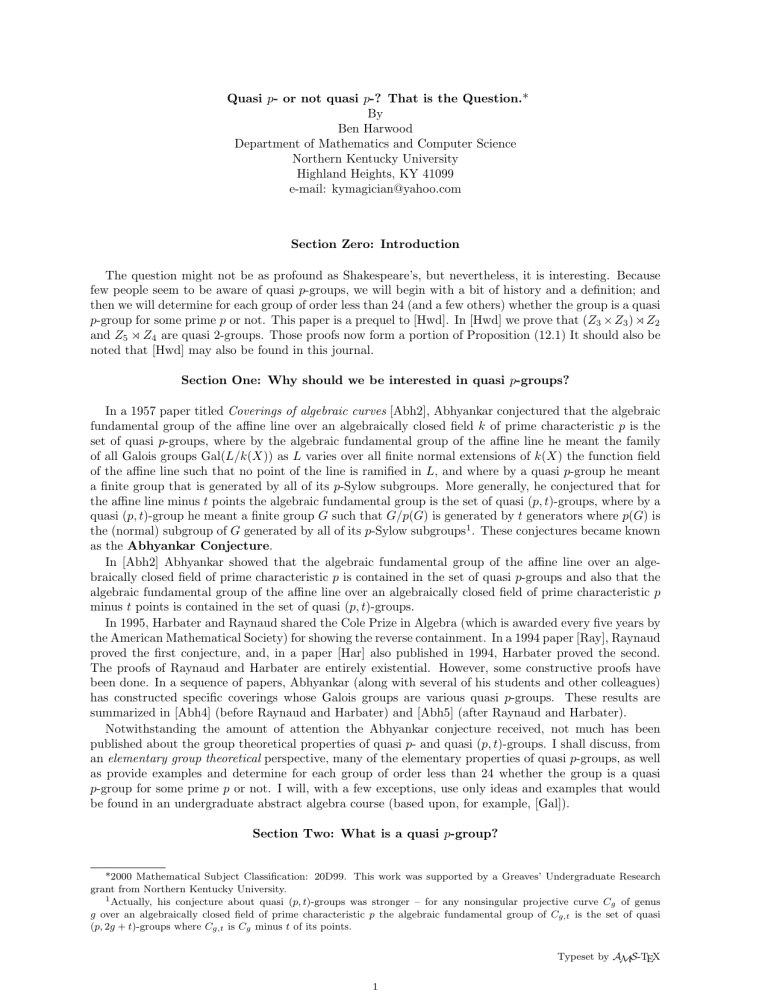
Quasi p- or not quasi p-? That is the Question.*
By
Ben Harwood
Department of Mathematics and Computer Science
Northern Kentucky University
Highland Heights, KY 41099
e-mail: kymagician@yahoo.com
Section Zero: Introduction
The question might not be as profound as Shakespeare’s, but nevertheless, it is interesting. Because
few people seem to be aware of quasi p-groups, we will begin with a bit of history and a definition; and
then we will determine for each group of order less than 24 (and a few others) whether the group is a quasi
p-group for some prime p or not. This paper is a prequel to [Hwd]. In [Hwd] we prove that (Z3 × Z3 ) o Z2
and Z5 o Z4 are quasi 2-groups. Those proofs now form a portion of Proposition (12.1) It should also be
noted that [Hwd] may also be found in this journal.
Section One: Why should we be interested in quasi p-groups?
In a 1957 paper titled Coverings of algebraic curves [Abh2], Abhyankar conjectured that the algebraic
fundamental group of the affine line over an algebraically closed field k of prime characteristic p is the
set of quasi p-groups, where by the algebraic fundamental group of the affine line he meant the family
of all Galois groups Gal(L/k(X)) as L varies over all finite normal extensions of k(X) the function field
of the affine line such that no point of the line is ramified in L, and where by a quasi p-group he meant
a finite group that is generated by all of its p-Sylow subgroups. More generally, he conjectured that for
the affine line minus t points the algebraic fundamental group is the set of quasi (p, t)-groups, where by a
quasi (p, t)-group he meant a finite group G such that G/p(G) is generated by t generators where p(G) is
the (normal) subgroup of G generated by all of its p-Sylow subgroups1 . These conjectures became known
as the Abhyankar Conjecture.
In [Abh2] Abhyankar showed that the algebraic fundamental group of the affine line over an algebraically closed field of prime characteristic p is contained in the set of quasi p-groups and also that the
algebraic fundamental group of the affine line over an algebraically closed field of prime characteristic p
minus t points is contained in the set of quasi (p, t)-groups.
In 1995, Harbater and Raynaud shared the Cole Prize in Algebra (which is awarded every five years by
the American Mathematical Society) for showing the reverse containment. In a 1994 paper [Ray], Raynaud
proved the first conjecture, and, in a paper [Har] also published in 1994, Harbater proved the second.
The proofs of Raynaud and Harbater are entirely existential. However, some constructive proofs have
been done. In a sequence of papers, Abhyankar (along with several of his students and other colleagues)
has constructed specific coverings whose Galois groups are various quasi p-groups. These results are
summarized in [Abh4] (before Raynaud and Harbater) and [Abh5] (after Raynaud and Harbater).
Notwithstanding the amount of attention the Abhyankar conjecture received, not much has been
published about the group theoretical properties of quasi p- and quasi (p, t)-groups. I shall discuss, from
an elementary group theoretical perspective, many of the elementary properties of quasi p-groups, as well
as provide examples and determine for each group of order less than 24 whether the group is a quasi
p-group for some prime p or not. I will, with a few exceptions, use only ideas and examples that would
be found in an undergraduate abstract algebra course (based upon, for example, [Gal]).
Section Two: What is a quasi p-group?
*2000 Mathematical Subject Classification: 20D99. This work was supported by a Greaves’ Undergraduate Research
grant from Northern Kentucky University.
1 Actually, his conjecture about quasi (p, t)-groups was stronger – for any nonsingular projective curve C of genus
g
g over an algebraically closed field of prime characteristic p the algebraic fundamental group of Cg,t is the set of quasi
(p, 2g + t)-groups where Cg,t is Cg minus t of its points.
Typeset by AMS-TEX
1
2
The term quasi p-group first appeared in [Abh1]; however, the idea appeared earlier with a different
name. (See [Abh3] and [Abh2].) Abhyankar defined a quasi p-group as follows:
Definition (2.1). A finite group G is called a quasi p-group if it is equal to p(G), the (normal) subgroup
of G generated by all of its p-Sylow subgroups.
We will prove that this definition is equivalent to two others, but first we prove two lemmas.
Lemma (2.2). Let G be a finite group such that p divides |G| the order of G. Let N be a normal
subgroup of G, which we denote by N /G. Let |G|p denote the p-order of G; i.e., the maximum power of
p that divides the order of G. Assume that |N |p = |G|p . Then N contains all elements of G whose order
is a power of p. In particular, p(G) is a subgroup of N which we denote by p(G) ≤ N .
Proof: Assume, by way of contradiction, that there exists g ∈ G such that |g| = pβ where β > 0 and
β
g 6∈ N . Consider the coset gN . Because (gN )p = N the order of gN must divide pβ . Say, |gN | = pγ ,
γ
1 ≤ γ ≤ β. So, p divides |G/N |p = |G|p /|N |p = 1. This is a contradiction and completes the proof. ¤
Lemma (2.3). Let G be a finite group whose order is divisible by p. Then |G|p = |p(G)|p .
Proof: Let H be a p-Sylow subgroup of G. Then H ≤ p(G) ≤ G. So, |H|p ≤ |p(G)|p ≤ |G|p . Because
|H|p = |G|p , |G|p = |p(G)|p . ¤
Now that we have these two lemmas, we can show two alternative definitions of a quasi p-group.
Proposition (2.4). If G is a finite group, then the following are equivalent: 1. G is a quasi p-group. 2.
G is generated by all of its elements whose order is a power of p. 3. G has no nontrivial quotient group
whose order is prime to p.
Proof: Assume that G is a quasi p-group; i.e., G is generated by all of its p-Sylow subgroups. If
|G|p = pα , then every p-Sylow subgroup has order pα , and every element of the p-Sylow subgroups has
order pβ where β ≤ α. In particular, every element of the p-Sylow subgroups has order a power of p.
Because G is generated by all of its p-Sylow subgroups, G is generated by elements whose orders are
powers of p. Therefore (1) implies (2).
Assume that G is generated by all of its elements whose orders are powers of p. Because every element
of G whose order is a power of p is contained in some p-Sylow subgroup of G, (2) implies (1).
Again, assume that G is a quasi p-group. Furthermore, assume, by way of contradiction, that for some
proper normal subgroup N of G, the order of G/N is prime to p. So, |G/N |p = 1. By Lemma (2.2),
p(G) ≤ N , which implies that p(G) is a proper subgroup of G, which is denoted by p(G) < G. Because
this is a contradiction, our assumption that for some proper normal subgroup N of G, the order of G/N
is prime to p is false. Therefore, (1) implies (3).
Finally, assume that G has no nontrivial quotient group whose order is prime to p, and assume, by
way of contradiction, that p(G) 6= G. Then p(G) is a proper normal subgroup of G, which we denote
by p(G) / G, and by Lemma (2.3) |G/p(G)|p = 1. Because this is a contradiction, our assumption that
p(G) 6= G is false. Therefore, (3) implies (1). ¤
The alternative definitions are what we will use in this paper. (2) will be used primarily to prove that
a group is a quasi p-group by constructing generators whose orders are powers of p, and (3) will be used
primarily to prove that a group is not a quasi p-group when we are able to capture all the power of p
order elements in a proper normal subgroup.
Notice that quasi p-groups need to have “many” p-Sylow subgroups. At least by (3) if G were a group
with a unique proper p-Sylow subgroup, then G would not be a quasi p-group.
Recall that a group G is a p-group if every element of G has order a power of p. Obviously every
p-group is a quasi p-group. But, it is easy to see that the order of a finite p-group must be a power of p,
and this is not the case with quasi p-groups. Here are two examples.
The symmetric group of degree n Sn is a quasi 2-group because for all n, Sn is generated by
transpositions (2-cycles) which are elements of order 2. But, |Sn | = n!. We shall prove later that Sn is
only a quasi 2-group.
The alternating group of degree n > 2 An is a quasi 3-group because for all n > 2, An is generated
by 3-cycles. But, |An | = n!/2.
3
Section Three: What about homomorphic images and extensions?
First, we note that the homomorphic image of a quasi p-group is a quasi p-group.
Proposition (3.1). Let G be a quasi p-group, and let φ : G → H be a homomorphism onto H. Then
H is a quasi p-group.
Proof: If H is a trivial homomorphic image (i.e., if either H = G or H is the identity), then the
result is true. So, assume that H is a nontrivial homomorphic image of G. Now, assume, by way of
contradiction, that there exists a proper normal subgroup NH of H such that |H/NH | is prime to p.
Consider the canonical homomorphism τ : H → H/NH . Composing the two homomorphisms we obtain
τ ◦ φ : G → H/NH where |H/NH | is prime to p. Notice that Ker(τ ◦ φ) / G and G/Ker(τ ◦ φ) ∼
= H/NH
where |H/NH | is prime to p; therefore, |G/Ker(τ ◦ φ)| is prime to p, which is a contradiction because G
is a quasi p-group. ¤
Next we consider extensions of quasi p-groups.
Proposition (3.2). Assume that N /G, N is a quasi p-group, and G/N is a quasi p-group; then G is
also a quasi p-group.
Proof: Assume, by way of contradiction, that G is not a quasi p-group. Then N / G. Because N is a
quasi p-group, it is contained in p(G). Because N ≤ p(G)/G, h1i = N/N ≤ p(G)/N /G/N . In particular,
p(G)/N / G/N . Now |G/N |/|p(G)/N | = |G/p(G)| which is prime to p. This is a contradiction because
G/N is a quasi p-group. ¤
Section Four: Simple groups provide many examples of quasi p-groups.
Proposition (4.1). Let G be a simple group. If a prime p divides the order of G, then G is a quasi
p-group.
Proof: Because p divides the order of G, p(G) 6= h1i. Because p(G) is normal in G and G is simple,
p(G) = G ;i.e., G is a quasi p-group. ¤
Therefore, the finite simple groups provide many examples of quasi p-groups.
Recall that the Classification of the Finite Simple Groups claims that the finite simple groups
consist of the cyclic groups Zp , the alternating groups An for n ≥ 5, 16 infinite families, and 26 sporadic
groups. A good discussion of the 110 year history and the current status of the proof of the classification
is given in [Sol].
For example, the Monster whose order is 246 350 59 76 112 133 171 191 231 291 311 411 471 591 711 is, therefore,
a quasi p-group for p = 2, 3, 5, 7, 11, 13, 17, 19, 23, 29, 31, 41, 17, 59, 71.
Section Five: What about symmetric groups and alternating groups?
We noted in Section Two that Sn the symmetric group of degree n is a quasi 2-group. We now show
that it is only a quasi 2-group.
Proposition (5.1). For n ≥ 2, Sn the symmetric group of degree n is always a quasi 2-group, but it is
not a quasi p-group for any prime p 6= 2.
Proof: Because Sn is generated by 2-cyles, it is always a quasi 2-group. To prove the rest, consider
Sn /An . The order of this quotient group is 2; so, Sn has a nontrivial quotient group whose order is prime
to every prime except p = 2. Therefore, Sn can only be a quasi 2-group. ¤
We also noted in Section Two that An the alternating group for n > 2 is a quasi 3-group. We can say
a bit more than that.
Proposition (5.2). Consider the alternating group An : 1. For n > 2, An is always a quasi 3-group. 2.
A3 is only a quasi 3-group. 3. A4 is only a quasi 3-group. 4. If n ≥ 5, An is a quasi p-group for all p
dividing |An |.
4
Proof: To prove (1), we know that if n > 2 then An is generated by 3-cycles; so, it is a quasi 3-group.
To prove (2), notice that |A3 | = 3. (So, A3 ∼
= Z3 .) The only prime that divides 3 is 3 itself; so, A3 can
only be a quasi 3-group.
To prove (3), notice that |A4 | = 12 = 22 3. A4 has only one 2-Sylow subgroup (see, for example, [DF]
p. 112), say Q. Therefore, Q / A4 . Notice that |A4 /Q| = 3. So, A4 has a nontrivial quotient group whose
order is prime to every prime except p = 3. Therefore, A4 can only be a quasi 3-group.
Finally, to prove (4), recall that for n ≥ 5, An is a simple group. This result follows from Proposition
(4.1). ¤
Section Six: What about dihedral groups?
Dihedral groups are familiar and provide interesting examples of quasi 2-groups.
Proposition (6.1). The dihedral group D2n = {s, r : s2 = 1, rn = 1, rs = sr−1 } is always a quasi
2-group, but it is not a quasi p-group for any prime p 6= 2.
Proof: We know that D2n contains a normal subgroup isomorphic to Zn – the rotation subgroup.
Notice that |D2n /Zn | = 2; so, D2n has a nontrivial quotient group whose order is prime to every prime
except p = 2. Therefore, D2n can only be a quasi 2-group.
To prove that it is always a quasi 2-group, we consider D2n to be given by generators and relations as
in the statement of the proposition. D2n consists of the identity 1; the rotations r, r2 , ..., rn−1 ; and the
reflections s, sr, sr2 , ..., srn−1 . Each of the reflections has order 2. Consider the products of s and each
of the reflections. For each j = 1, 2, ..., n − 1; s(srj ) = rj . Therefore, the reflections, which are elements
of order 2, generate D2n , and D2n is a quasi 2-group.
Thus, D2n is always and only a quasi 2-group. ¤
Section Seven: What about direct products?
In the next section we will examine abelian and nilpotent groups, but before doing that an analysis of
direct products would be most beneficial.
Proposition (7.1). Let G = H × K. Then for a prime p, G is a quasi p-group if and only if both H
and K are quasi p-groups.
Proof: First, assume that G is a quasi p-group. Then, by Proposition (3.1), K ∼
= G/H is a quasi
p-group, and H ∼
= G/K is a quasi p-group.
Now assume that H and K are both quasi p-groups. Notice that p(H) × h1i ≤ p(G) and h1i × p(K) ≤
p(G). Therefore, G = H × K = p(H) × p(K) ≤ p(G). This implies that p(G) = G; i.e., G is quasi
p-group. ¤
It is easy to find an example of a direct product that is not a quasi p-group for any prime p. For
example, Z6 ∼
= Z2 × Z3 is not a quasi p-group for any prime p by Proposition (2.4)(3). The problem is
that the 2(Z6 ) / Z6 and 3(Z6 ) / Z6 ; there are “too many” proper normal subgroups or equivalently there
are “too few” 2-Sylow and 3-Sylow subgroups.
Section Eight: Only a few cyclic, abelian, and nilpotent groups are quasi p-groups.
Recall the following hierachy of finite groups: cyclic groups ⊂ abelian groups ⊂ nilpotent groups ⊂
solvable groups ⊂ all finite groups. We will consider cyclic, abelian, and nilpotent quasi p-groups in this
section and solvable groups in the next.
Proposition (8.1). The cyclic group Zn is a quasi p-group if and only if it is a p-group.
Proof: Because every p-group is a quasi p-group, it is only necessary to show that if Zn is a quasi
p-group then Zn is a p-group. Assume, by way of contradiction, that p divides n but that n is not a
power of p. Say, |Zn |p = pα . Then Zn has a unique proper normal subgroup N of order pα . Then
p(Zn ) = N 6= Zn which is a contradiction. Therefore, if Zn is a quasi p-group, then n = pα . ¤
Combining this result with the Fundamental Theorem of Finite Abelian Groups and Proposition (7.1)
yields the following:
5
Proposition (8.2). A finite abelian group G is a quasi p-group if and only if it is a p-group.
Proof: By the Fundmental Theorem of Finite Abelian Groups, G ∼
= Zn1 × Zn2 × ... × Zns .
Because every p-group is a quasi p-group, it is only necessary to show that if G is a quasi p-group then
G is a p-group.
So, assume that G is a quasi p-group. By Proposition (7.1) each of the factors in the direct product
must also be a quasi p-group. Then Proposition (8.1) tells us that each factor must in fact be a p-group;
so, G is a p-group. ¤
There are several equivalent definitions of a nilpotent group. We will take as definition the one that is
most applicable to our study of quasi p-groups.
Definition (8.3). Let G be a finite group and let p1 , p2 , ..., ps be the distinct primes dividing the order
of G and for each i = 1, 2, ..., s let Pi be a pi -Sylow subgroup of G. G is nilpotent if G ∼
= P1 × P2 × ... × Ps .
(See, for example, [DF] p. 193.)
Proposition (8.4). A finite nilpotent group G is a quasi p-group if and only if it is a p-group.
Proof: Again it is only necessary to show that if G is a quasi p-group then G is a p-group. Let
p1 , p2 , ..., ps be the distinct primes dividing the order of G. Because G is nilpotent, G ∼
= P1 × P2 × ... × Ps
where for each i = 1, 2, ..., s let Pi be a pi -Sylow subgroup of G. By Proposition (7.1), because G is a
quasi p-group, each Pi must be a p-group; therefore, there is only one prime p that divides the order of
G. G is a p-group. ¤
Section Nine: But, solvable quasi p-groups need not be p-groups.
The next step in the hierarchy is solvable groups. Following the pattern we have had up to now with
cyclic, abelian, and nilpotent groups, one might guess that a finite solvable group is a quasi p-group if
and only if it is p-group. This is not the case, however.
Example (9.1). S3 is a finite solvable group, and it is a quasi 2-group. But, the order of S3 is 6, which
is not a power of 2. So, a solvable quasi p-group need not be a p-group.
Also, a solvable group need not be a quasi p-group.
Example (9.2). Z6 is solvable, but it is neither a quasi 2-group nor a quasi 3-group.
Finally, notice that:
Example (9.3). By Propositions (2.4) and (4.1), the only simple solvable quasi p-group is Zp .
Section Ten: Semidirect products provide many interesting examples.
Although we have not made use of the fact so far, several of the groups that we have considered are
semidirect products. We now examine the relationship between semidirect products and quasi p-groups.
Semidirect products are not a standard topic in a first course in abstract algebra, but they could be.
[DF], [Hal], and [Rot] each discusses this topic. A quick introduction (which is enough for our needs)
may be found in [AbC].
Proposition (10.1). Let H and K be quasi p-groups. Then G, the semidirect product of H and K
which we denote by G ∼
= H o K, is also a quasi p-group.
Proof: Assume, by way of contradiction, that there exists a proper normal subgroup N / G such
that |G/N | is prime to p. Therefore, N contains all elements of G of p-power order, and, in particular,
p(H) ≤ N . But, because H is a quasi p-group and a subgroup of G, H = p(H) ≤ N . Under the
homomorphism G → G/H ∼
= K, N is isomorphic to N/H which is normal in G/H which is isomorphic
to K: N → N/H / G/H ∼
= K. Let N ∗ denote the image of N in K under this isomorphism. So, we have
N ∗ / K and K/N ∗ ∼
= (G/H)/(N/H) ∼
= G/N . In particular, |K/N ∗ | = |G/N |. But |G/N | is prime to p;
so, K is not a quasi p-group. This is a contradiction, which completes the proof. ¤
6
Proposition (10.2). If G ∼
= H o K is q quasi p-group, then K is also a quasi p-group.
Proof: Consider G/H ∼
= K. Because G is a quasi p-group, by Proposition (3.1) K is also a quasi
p-group. ¤
Application (10.3). Recall that in Example (2.5) we pointed out that Sn is a quasi p-group. As a
result of Proposition (10.2) we see that Sn can only be a quasi 2-group because Sn ∼
= An o Z2 .
Application (10.4). Recall that in Proposition (6.1) we proved that D2n is always a quasi 2-group but
not a quasi p-group for any other prime p. The second half of this now follows from Proposition (10.2)
by noting that D2n ∼
= Zn o Z2 .
Example (10.5). Notice that if G ∼
= H o K is a quasi p-group then H need not be a quasi p-group.
Just notice that S3 ∼
= Z3 o Z2 is a quasi 2-group but Z3 is not a quasi 2-group.
Definition (10.6). We will call a semidirect product a proper semidirect product if it is not a direct
product.
Notice that a direct product is a quasi p-group if and only if its factors are quasi p-groups. But, because
proper semidirect products have one factor that is not normal, if that factor is a quasi p-group and if
there are enough copies of that factor in the group, the semidirect product might be a quasi p-group.
Example (10.7). Based upon examples, it was tempting to conjecture that all proper semidirect products whose non-normal factor is a quasi p-group are quasi p-groups. But, this is not the case. S3 × Z3
which is a group of order 18 is “quasi nothing” by Proposition (7.1), but S3 × Z3 is a wreath product
Z3 o Z2 , and therefore, is a proper semidirect product.
Section Eleven: Is a group of order pq a quasi p-group?
Next we will consider all groups of order pq where p and q are distinct primes. Such groups are typically
treated in graduate courses in abstract algebra.
Proposition (11.1). Let |G| = pq, with p < q. 1. If p does not divide q − 1, then G is not a quasi
p-group. 2. If p divides q − 1, then G is only a quasi p-group.
Proof: To prove (1), we note that if p does not divide q − 1, then G is cyclic of order pq. (See, for
example, [DF] pp. 183 and 184 or [Hal] pp. 49 and 50.) Therefore, by Proposition (8.1) G is not a quasi
p-group.
To prove (2), we note that G ∼
= Zq o Zp . Furthermore, this is the unique non-abelian group of order
pq and there are exactly q p-Sylow subgroups. (See, for example, [Hal] pp. 49 and 50.) Let hxi be the
unique normal subgroup isomorphic to Zq , and let hyi be one of the p-Sylow subgroups. Notice that the
p-Sylow subgroups account for the identity and q(p − 1) = qp − q elements of order p. The remaining
elements of G are {x, x2 , ..., xq−1 }. We want to show that these elements can be generated by elements
of order a power of p.
Consider the element yx. We claim that the order of yx is p. Because |G| = pq the only possibilities
for |yx| are pq, p, q, 1. G is not cyclic; so, |yx| 6= pq. |yx| = 1 is not possible because this would imply that
|y| = |x−1 |, but |y| = p and |x| = q. If |yx| = q, then yx ∈ hxi; i.e., for some m ∈ {1, ..., q − 1}yx = xm .
This would imply that y = xm−1 , which is not possible (because for each m ∈ {1, ..., q − 1}, xm has order
q whereas y has order p). Therefore, we can conclude that |yx| = p.
Because y has order p, y −1 also has order p. So, because yx and y −1 each have order p; x = y −1 (yx)
is generated by elements of order p. Therefore each of the elements in hxi is generated by elements of
order a power of p, and we can conclude that G is a quasi p-group. ¤
Section Twelve: Classification of the groups of order less than 24.
For the groups of order less than 24, we present two tables (taken from [DF]) – one for the abelian
groups and one for the non-abelian groups, and we classify those according to whether they are quasi
p-groups for some prime p or not. For the abelian groups, all results follow from Proposition (8.2).
7
Abelian groups of order less than 24
Order
Group
1
Z1
2
Z2
3
Z3
4
Z4
4
Z2 × Z2
5
Z5
6
Z6
7
Z7
8
Z8
8
Z4 × Z2
8
Z2 × Z2 × Z2
9
Z9
9
Z3 × Z3
10
Z10
11
Z11
12
Z12
12
Z6 × Z2
13
Z13
14
Z14
15
Z15
16
4 groups
17
Z17
18
Z18
18
Z6 × Z3
19
Z19
20
Z20
20
Z10 × Z2
21
Z21
22
Z22
23
Z23
Quasi p-group
p-group for every prime p
2-group
3-group
2-group
2-group
5-group
quasi nothing
7-group
2-group
2-group
2-group
3-group
3-group
quasi nothing
11-group
quasi nothing
quasi nothing
13-group
quasi nothing
quasi nothing
2-groups
17-group
quasi nothing
quasi nothing
19-group
quasi nothing
quasi nothing
quasi nothing
quasi nothing
23-group
Nonabelian groups of order less than 24
Order
Group
6
S3
8
D8
8
Q8
10
D10
12
A4
12
D12
12
Z3 o Z4
14
D14
16
9 groups
18
D18
18
S 3 × Z3
18
(Z3 × Z3 ) o Z2
20
D20
20
Z5 o Z4
20
F20
21
Z7 o Z3
22
D22
Quasi p-group
quasi 2-group by 5.1 or 11.1
2-group or by 6.1
2-group
quasi 2-group by 6.1 or 11.1
quasi 3-group by 5.2
quasi 2-group by 6.1
quasi 2-group by 12.1
quasi 2-group by 6.1 or 11.1
2-groups
quasi 2-group by 6.1
quasi nothing by 7.1
quasi 2-group by 12.1
quasi 2-group by 6.1
quasi 2-group by 12.1
quasi 2-group by 12.2
quasi 3-group by 11.1
quasi 2-group by 6.1 or 11.1
8
Proposition (12.1). Each of Z3 o Z4 , (Z3 × Z3 ) o Z2 , and Z5 o Z4 is only a quasi 2-group.
Proof: The proofs for (Z3 × Z3 ) o Z2 , and Z5 o Z4 can be found in [Hwd]. Here we will prove that
Z3 o Z4 is only a quasi 2-group; the proof is similar to the proof for Z5 o Z4 .
In terms of generators and relations, Z3 o Z4 = hx, y|x4 = y 3 = 1, x−1 yx = y −1 i. So, x ∈ 2(Z3 o Z4 ).
If we can get y ∈ 2(Z3 o Z4 ), we will be done because then 2(Z3 o Z4 ) = Z3 o Z4 . Notice that because
x−1 yx = y −1 , yx = xy −1 = xy 2 . Now consider the order of xy. (xy)2 = xyxy = xxy 2 y = x2 . So, the
order of xy is 4, and, therefore, xy ∈ 2(Z3 o Z4 ). Because x, xy ∈ 2(Z3 o Z4 ), y = x−1 xy ∈ 2(Z3 o Z4 );
and we can conclude that Z3 o Z4 is a quasi 2-group.
Because all the elements of order 3 in Z3 o Z4 are in the factor Z3 , 3(Z3 o Z4 ) is a proper subgroup
of Z3 o Z4 . Therefore, Z3 o Z4 is only a quasi 2-group. ¤
The group identified in the table of non-abelian groups as F20 is the Frobenius group of order 20.
It has generators and relations (See, for example, [DF] p. 170.): F20 = hx, y, |y 4 = x5 = 1, yxy −1 = x2 i,
or we can think of it as a subgroup of S5 : F20 = h(2354), (12345)i. We will use the permutation
representation and show, using a brute force argument similar to the arguments in Proposition (11.1)
and Proposition (12.1), that F20 is a quasi 2-group.
Proposition (12.2). F20 is only a quasi 2-group.
Proof: Let x = (12345) and y = (2354). It is clear from the definition by generators and relations or
by constructing the subgroup lattice that H = hxi = h(12345)i is a normal subgroup of G. Therefore,
we remark that G = F20 is not a quasi 5-group. Now H contains the identity and 4 elements of order 5.
Using x and y we can construct the remaining 15 elements of G. The subgroup lattice of G contains 5
2-Sylow subgroups – each of order 4. These account for the remaining 15 elements of G; each of these 15
nonidentity elements has order a power of 2. Let G1 = h(2345)i which contains the subgroup h(25)(34)i of
order 2. Let G2 = h(1435)i which contains the subgroup h(13)(45)i of order 2. Let G3 = h(1254)i which
contains the subgroup h(15)(24)i of order 2. Let G4 = h(1325)i which contains the subgroup h(12)(35)i
of order 2. Let G5 = h(1243)i which contains the subgroup h(14)(23)i of order 2. Following the pattern
used in Proposition (11.1) that (yx)(y 4−1 x1−2 ) = (yxy 3 )x−1 = (yxy −1 )x−1 = x2 x−1 = x, we see that
(1325)(1342) = [(2354)(12345)][(2453)(15432)] = (12345) which is a generator for H. Notice that each
of (1325) ∈ G4 and (1342) ∈ G5 has order a power of 2. So the elements of G = F20 whose order is a
power of 2 generate H. Therefore, they generate G. So G = F20 is a quasi 2-group, and it is only a quasi
2-group by the remark at the beginning of the proof. ¤
Definition (12.3). A finite group G is called a Frobenius group with Frobenius kernel Q if Q is a
proper, nontrivial normal subgroup of G and CG (x) ≤ Q, where CG (x) denotes the centralizer of x in G,
for all nonidentity elements x of Q. (See, for example, [DF] p. 862.)
Although this definition is made for abstract finite groups, Frobenius groups come from the tradition
of permutation groups. (A permutation group is a group which is a subgroup of Sn for some n). For this
discussion, we think of Frobenius groups as permutation groups.
Comment (12.4). In 1901, Frobenius showed that the Frobenius kernel is always a regular normal
subgroup and that it consists of the identity together with those elements that fix no element of the
permuted set.
For F20 , the Frobenius kernel is H = h(12345)i = {(12345), (13542), (14253), (15432), (1)}.
Comment (12.5). A Frobenius group is the semidirect product of the Frobenius kernel by a Frobenius
complement.
For F20 , the Frobenius complements are G1 , G2 , G3 , G4 , G5 . They are isomorphic, and for i = 1, 2, 3, 4, 5
Gi is the stabilizer of i – the subgroup of permutations that stabilize i.
More about Frobenius groups may be found in [Abh2] pp. 78 and 79, [DF], [Hal], [Pas], [Rot], and
[Wie].
9
Section Thirteen: How about infinite quasi p-groups?
Abhyankar’s definition of a quasi p-group requires that the group be finite. Before ending, although
we will not in this paper examine any of their properties, we would like to suggest a definition for infinite
quasi p-groups.
Definition (13.1). A group G of infinite order is said to be a quasi p-group if G = p(G).
G = S2 × S3 × S4 × ... is an example of an infinite quasi 2-group.
Section Fourteen: Conclusions.
Normal p-Sylow subgroups are bad – at least as far as quasi p-groups are concerned. If p(G) is a
proper normal subgroup of G, then G cannot be a quasi p-group (Proposition (2.4)). On the other
hand, simple groups provide lots of examples of quasi p-groups (Proposition (4.1)). Cyclic, abelian, and
nilpotent groups are quasi p-groups if and only if they are p-groups (Propositions (8.1), (8.2), and (8.4)).
But, solvable quasi p-groups need not be p-groups (Proposition (9.1)); however, simple, solvable quasi
p-groups are p-groups (Proposition (9.3)). Proper semidirect products (e.g., D2n , Sn , and F20 ) that are
quasi p-groups have a normal subgroup, but they have lots of p-Sylow subgroups. Quasi p-groups are
“almost simple.”
Section Fifteen: Acknowledgements
This work was the result of a Greaves’ Undergraduate Summer Research Project at Northern Kentucky
University. I am grateful for that support. I am also indebted to Dr. Chris Christensen. Without his
guidance and support, this would not have been possible.
REFERENCES
[Abh1]
[Abh2]
[Abh3]
S. S. Abhyankar, On the ramification of algebraic functions, Amer. J. Math. 77 (1955), 572-592.
S. S. Abhyankar, Coverings of algebraic curves, Amer. J. Math. 79 (1957), 852-856.
S. S. Abhyankar, On the ramification of algebraic functions part II: Unaffected equations for
characteristic two, Amer. J. Math. 89 (1958), 310 - 324.
[Abh4] S. S. Abhyankar, Galois theory on the line in nonzero charcteristic, Bulletin of the American
Mathematical Society 27 (1992), 68 - 133.
[Abh5] S. S. Abhyankar, Resolution of singularities and modular Galois theory, Bulletin of the American
Mathematical Society 38 (2001), 131 - 169.
[AbC] S. S. Abhyankar and C. Christensen, x 7→ ax+b: A pathway to the semidirect product, To appear
in Mathematics Magazine.
[DF]
D. S. Dummit, and R. M. Foote, Abstract Algebra, John Wiley and Sons, Inc., 1999.
[Gal]
J. Gallian, Contemporary Abstract Algebra, Houghton Mifflin, 1998.
[Hal]
M. Hall, The Theory of Groups, Macmillan, 1959.
[Har]
D. Harbater, Abhyankar’s conjecture on Galois groups over curves, Inventiones Mathematicae
117 (1994), 1 - 25.
[Hwd] B. Harwood, Two quasi 2-groups, Rose-Hulman Undergraduate Math Journal 3 (2002), http://www.rosehulman.edu/mathjournal/.
[Pas]
D. S. Passman, Permutation Groups, Benjamin, 1968.
[Ray]
M. Raynaud, Revêtment de la droit affine en charactéristic p > 0 et conjecture d’Abhyankar,
Inventiones Mathematicae 116 (1994), 452 - 462.
[Rot]
J. J. Rotman, An Introduction to the Theory of Groups, Fourth Edition, Springer-Verlag, 1995.
[Sol]
R. Solomon, A brief history of the classification of the finite simple groups, Bulletin of the
American Mathematical Society 38 (2001), 315 - 350.
[Wie]
H. Wielandt, Finite Permutation Groups, Academic Press, 1964.

